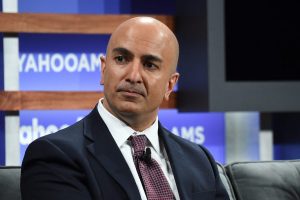The US labor market is stuck in a 'deep hole' and needs more support, Minneapolis Fed president says

- April jobs data proves officials should keep supporting the recovery, Minneapolis Fed Pres. Neel Kashkari said.
- Unemployment benefits likely contributed to the weak hiring along with virus fears and childcare needs, he added.
- Kashkari praised Congress and the Fed for their “aggressive” policy support over the past year.
- See more stories on Insider’s business page.
The dismal April jobs report underscores just how far the US has to go in reviving its labor market, Neel Kashkari, president of the Federal Reserve Bank of Minneapolis, said Sunday.
What was expected to be another month of stellar job growth instead shocked economists and showed the fragility of the US economic recovery. The US added just 266,000 nonfarm payrolls in April, according to data published by the Bureau of Labor Statistics on Friday. That compares to a median estimate of 1 million payrolls and the downwardly revised March sum of 770,000.
Americans “shouldn’t overreact to any one report,” but the data proves the country is far from a full recovery, Kashkari said on CBS’ “Face the Nation.” A strong pickup in consumer spending suggests pockets of the economy are roaring back. Still, policymakers shouldn’t retreat from providing support until millions more Americans find their way back into the workforce, the Fed president said.
“Roughly eight to 10 million Americans ought to be working right now if the COVID crisis had not happened,” Kashkari said. “We still are in a deep hole and we still need to do everything we can to put those folks back to work more quickly.”
Pegging the weak April figures to any single factor is misguided, he added. The shortfall led many Republicans to immediately blame expanded unemployment benefits for diminishing the incentive to work.
President Joe Biden rebuked such claims on Monday, saying the benefit helped keep millions of Americans afloat. He added that jobless Americans who refuse work shouldn’t be able to stay on unemployment insurance, although his administration clarified he was not announcing a new policy, rather a reinstatement of prior requirements that would be up to states to implement.
There is “some truth” in the disincentive argument, but other dynamics are playing major roles in slowing the hiring boom, Kashkari said. Childcare shortages are forcing many parents to miss out on work, at least until school is back in session. For countless others, the risk of contracting COVID-19 still outweighs the job search. These factors should fade over the next three to four months, and its likely hiring accelerates into the fall, the Fed president said.
“As the vaccine continues to penetrate, as the virus continues to slow down, schools reopen and people regain their confidence,” Kashkari said. “Those things should get better, which should lead to strong growth in the second half of the year and strong labor market recovery, I hope.”
Keeping the Fed’s foot on the gas
The Fed has already indicated it will maintain its ultra-accommodative policy stance into 2023 to ensure the recovery progresses. The central bank’s benchmark interest rate sits near zero, and it’s still buying at least $120 billion worth of Treasurys and mortgage-backed securities every month. Keeping rates at historically low levels encourages borrowing and, in theory, should promote hiring in the years after the pandemic.
Since the Fed introduced its emergency support measures in March 2020, chair Jerome Powell and the regional presidents have repeatedly backed plans to keep the help around well into the recovery. Fed officials have been less vocal in regard to fiscal stimulus. The central bank’s independence has long led its policymakers to refrain from endorsing or criticizing measures actively being debated in Congress.
Still, Kashkari noted that lawmakers’ actions so far have helped a great deal in lifting economic activity.
“The hope is that Congress has been so aggressive in the past year and the Federal Reserve has been so aggressive in the past year that we have positioned the economy for a fast recovery, not a 10 year recovery,” he said, adding there’s “still a great deal of uncertainty” around the virus.
Source: Read Full Article
